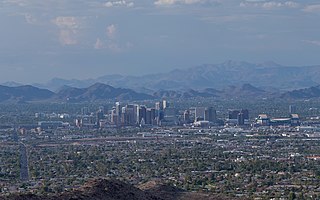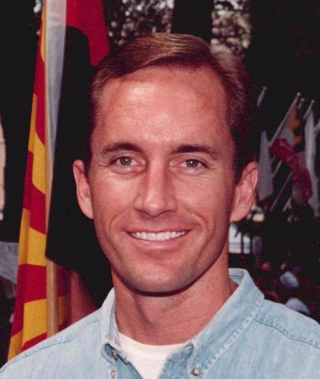
Maricopa County is in the south-central part of the U.S. state of Arizona. As of the 2020 census the population was 4,420,568, or about 62% of the state's total, making it the fourth-most populous county in the United States and the most populous county in Arizona, and making Arizona one of the nation's most centralized states. The county seat is Phoenix, the state capital and fifth-most populous city in the United States.

Scottsdale is a city in the eastern part of Maricopa County, Arizona, United States, and is part of the Phoenix metropolitan area. Named Scottsdale in 1894 after its founder Winfield Scott, a retired U.S. Army chaplain, the city was incorporated in 1951 with a population of 2,000. At the 2020 census, the population was 241,361, which had grown from 217,385 in 2010. Its slogan is "The West's Most Western Town". Over the past two decades, it has been one of the fastest growing cities in the United States.

The Phoenix metropolitan area, also known as the Valley of the Sun, the Salt River Valley, metro Phoenix, or The Valley, is the largest metropolitan statistical area in the Southwestern United States, with its largest principal city being the city of Phoenix. It includes much of central Arizona. The United States Office of Management and Budget designates the area as the Phoenix-Mesa-Chandler Metropolitan Statistical Area (MSA), defining it as Maricopa and Pinal counties. It anchors the Arizona Sun Corridor megaregion along with the second-most populous metropolitan area in the state, the Tucson metropolitan area. The gross domestic product of the Phoenix metropolitan area was $255 billion in 2018, 16th-largest amongst metro areas in the United States.

Hi Corbett Field is a baseball park in the southwestern United States, located in Tucson, Arizona. With a seating capacity of approximately 9,500, it was the spring training home of the Colorado Rockies and Cleveland Indians of Major League Baseball, and is currently home to the University of Arizona Wildcats of the Pac-12 Conference.

Tempe Diablo Stadium is a baseball field located in Tempe, Arizona. It has been the spring training home of the Los Angeles Angels since 1993, and it is the home field for night games of the Arizona League Angels. It was the spring training home of the Seattle Pilots in 1969 and 1970, the Milwaukee Brewers in 1971 and 1972, and the Seattle Mariners from 1977 through 1993.

Phoenix Municipal Stadium is a baseball stadium, located in Phoenix, Arizona. It is often referred in short as Phoenix Muni. The stadium was built in 1964 and holds 8,775 people. It is currently the home to the Arizona State Sun Devils baseball program, having relocated to Phoenix Municipal Stadium at the start of their 2015 season. It is the former spring training home to the Oakland A's, having played their home games from 1982 to 2014. The San Francisco Giants held spring training at the ballpark from 1964 to 1981, when they moved to Scottsdale Stadium.

Scottsdale Stadium is a baseball stadium located in Scottsdale, Arizona, United States. Designed by the architect of the Baltimore Orioles’ Camden Yards, Populous, the stadium was expanded to its current state in 1992 and holds 12,000 people. It has been the spring training home of the San Francisco Giants since 1984, when the capacity was just 4,721.
The Valley Metro Regional Public Transportation Authority, more popularly known as Valley Metro, is the unified public brand of the regional transit system for the Phoenix metropolitan area. Within the system, it is divided between Valley Metro Bus, which runs all bus operations, Valley Metro Rail, which is responsible for light rail and streetcar operations in the Valley. In 2023, the combined bus and rail system had a ridership of 36,374,000, or about 122,500 per weekday as of the fourth quarter of 2023.

State Farm Stadium is a multi-purpose retractable roof stadium in Glendale, Arizona, west of Phoenix. It is the home of the Arizona Cardinals of the National Football League (NFL) and the annual Fiesta Bowl. It replaced Sun Devil Stadium in Tempe as the home of the Cardinals, and is adjacent to Desert Diamond Arena, former home of the Arizona Coyotes of the National Hockey League.

State Route 30, also known as the Tres Rios Freeway, is a planned freeway in the southwest part of the Phoenix metropolitan area. It is planned as a reliever for Interstate 10 five miles to the south and will run through the communities of Buckeye, Goodyear, Avondale, and Phoenix.

Scott Bundgaard is a Republican politician who served in the Arizona House of Representatives and in the Arizona State Senate. Bundgaard was elected in 2010 as Majority Leader of the Arizona State Senate, and later served as Vice-Chairman of the Senate Finance Committee.

Salt River Fields at Talking Stick is a stadium complex located in the Salt River Pima–Maricopa Indian Community near Scottsdale, Arizona, at the former site of the Indian Bend Country Club. It serves as the Major League Baseball spring-training facility for the Arizona Diamondbacks and the Colorado Rockies, replacing Tucson Electric Park for the Diamondbacks and Hi Corbett Field for the Rockies. The complex represents the first MLB park to be built on Native American Indian land.
Many arterial roads in the Phoenix metropolitan area have the same name in multiple cities or towns. Some roads change names or route numbers across town borders, resulting in occasional confusion. For example, the road known as Apache Boulevard in Tempe continues east as Main Street in neighboring Mesa and then as Apache Trail in Apache Junction. Although Broadway Road maintains the same name through Goodyear, Avondale, Phoenix, Tempe, Mesa, and Apache Junction, each town uses a different reference point for address numbers.
Compadre Stadium was a stadium located in Chandler, Arizona. It was the spring training home of the Milwaukee Brewers from 1986 to 1997 and the home field of the Chandler Diamondbacks of the Arizona Fall League from 1992 to 1994. The ballpark was privately financed by local developers and built at a cost of $1.6 million in 1985. It closed in 1997 and sat abandoned for a number of years, with the outfield being used for grazing, before finally being demolished in 2014.
The following is a timeline of the history of the city of Phoenix, Arizona, United States.
Sports in Arizona includes professional sports teams, college sports, and individual sports. All four major league sports teams in Arizona are based in the Phoenix metropolitan area.

The New Tempe Arena was a proposed sports facility to be constructed in Tempe, Arizona which would have served as home arena for the Arizona Coyotes of the National Hockey League (NHL). This was part of a conceptual $1.7 billion Tempe Entertainment District. The proposal also included hotels, retail, apartments, and a theater. It was rejected by City of Tempe voters on May 16, 2023.














